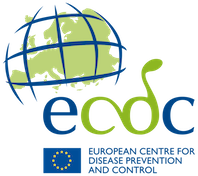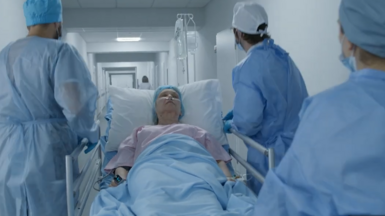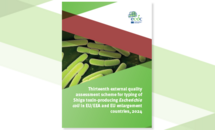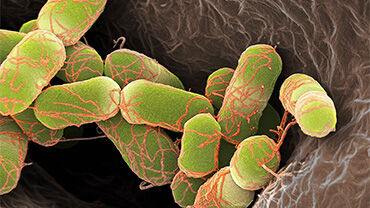Thirteenth external quality assessment scheme for typing of Shiga toxin-producing Escherichia coli in EU/EEA and EU enlargement countries, 2024
This report presents the results of the 13th round of the external quality assessment (EQA-13) scheme for typing of Shiga toxin-producing Escherichia coli (STEC). This EQA was organised for national public health reference laboratories (NPHRLs) providing data to the Food- and Waterborne Diseases and Zoonoses Network (FWD-Net) managed by the European Centre for Disease Prevention and Control (ECDC). Since 2012, the unit of Foodborne Infections at Statens Serum Institut (SSI) in Denmark has arranged the EQA under a framework contract with ECDC. EQA-13 contained serotyping, detection of virulence genes, and molecular typing-based cluster analysis.
Human STEC infection is a zoonotic disease. For 2023, 10 217 confirmed human cases of STEC illness in the EU were reported by 27 Member States. This placed STEC as the third most commonly reported gastrointestinal food- borne illness, responsible for a reported 66 foodborne outbreaks in the EU during 2023. Twenty-six countries reported at least one confirmed STEC case and only Cyprus reported zero cases. In 2023, the EU notification rate was 3.1 per 100 000 population. This marked an increase of 30.0% in the annual notification rate reported compared with the previous year (2022; 2.4 cases per 100 000 population). The rise can partly be attributed to new laboratory diagnostic testing methods used in several countries. In 2023, information on serogroup was available for just 31.9% of the total reported cases in the EU, which was a decrease compared to previous year.
The six most frequently reported serogroups were O157, O26, O146, O103, O145 (4.4%), and O63. Together, these six made up over 60% of cases, for which serogroup data were available.
Since 2007, ECDC has been responsible for the EU-wide surveillance of STEC, including facilitating the detection and investigation of food-borne outbreaks. Surveillance data, including basic typing parameters and molecular typing data for the isolated pathogen, are reported by Member States to The European Surveillance System (TESSy, since 2025 called EpiPulse Cases). The surveillance system relies on the capacity of NPHRLs in FWD-Net providing data to produce comparable typing results. To ensure that the EQA is linked to the development of surveillance methods used by NPHRLs, a molecular typing-based cluster analysis using whole genome sequencing (WGS)-derived data has been included since EQA-8.
The objectives of the EQAs are to assess the quality and comparability of typing data reported by NPHRLs participating in FWD-Net. The EQA test strains were selected to cover strains currently relevant to public health in Europe and represent a broad range of clinically relevant types of STEC. Twelve test strains were selected for serotyping/virulence profile determination and molecular typing-based cluster analyses. In addition, eight strains (sequences) were included for the molecular typing-based cluster analysis. Twenty-two laboratories registered and all of them completed the exercise.
In total, serotyping was performed by 21 laboratories (95%), 22 laboratories determining the virulence profile, and 19 (86%) engaging in cluster identification using WGS data analysed by different approaches. The full O:H serotyping was performed by 86% (18/21) of participating laboratories. In O:H serotyping, participants achieved a high average score of 98%. Despite the high overall score, however, not all laboratories demonstrated the capacity to determine all included O groups and H types, and the participation in H typing was lower (18/22) compared to the O grouping (21/22). In the reported O-grouping results 71% (15/21) used WGS-based methods, which is higher than EQA-12 (68%), EQA-11 (60%), EQA-10 (52%), EQA-9 (50%), and EQA-8 (26%), indicating a shift towards using WGS based methods for serotyping.
The performance in detecting the virulence genes was also high: 97% for stx1 and 95% for stx2, and 98% for the eae gene. The average score of laboratories that correctly performed the stx subtyping were 100% for stx1, 97% for stx2, and 97% for stx1 and stx2 combined. These results were similar to previous EQAs. In EQA-13, two other diarrhoeagenic E. coli (DEC) pathotypes were included, ETEC strain1 (esta gene) and EAEC Strain10 (aggR gene) testing the participating laboratories in their abilities to detect STEC hybrid strains. The detection performance of the aggR gene was lower (20/22, 91%) than in EQA-12 (23/24, 98%) and EQA-11 (95%). Similar to aggR, the performance for esta was also lower (17/20, 85%) than EQA-12 (98%) and EQA-11 (89%). Fifteen laboratories utilised a WGS-based method to identify the genes.
Of the 22 laboratories participating in EQA-13, 19 (86%) performed molecular typing-based cluster analysis using WGS data analysed by different approaches. Since EQA-11, all participating laboratories have chosen the WGS based method and again none chose PFGE, a decrease from EQA-10 (2 laboratories) and EQA-9 (8 laboratories). The purpose of the cluster analysis part of the EQA was to assess the NPHRL’s ability to identify a cluster of genetically closely related strains, i.e. to correctly categorise the cluster test strains regardless of the method used. The focus is on the result, not a specific procedure.
All participants (100%) correctly identified the cluster of closely related ST335 strains defined by pre-categorisation from the EQA provider among the 12 test strains and eight test strains (genomic sequences).
In this EQA, participants were free to choose their preferred analytical method for the WGS-based cluster identification. An allele-based method was most frequently used; 89% (17/19) used core genome Multi LocusSequence Typing (cgMLST) compared to 11% (2/19) using single nucleotide polymorphism (SNP) for the reported cluster analysis as the main analysis.
In general, for cgMLST the reported results from the participants were at a comparable level despite using various analysis and different allelic calling methods.
For inter-laboratory comparability and communication about cluster definitions, cgMLST using a standard scheme (e.g. Enterobase) gives a very high degree of homogeneity in the results, while the use of non-standardised SNP analysis may be more challenging. There are two main challenges: difficulty in comparing SNP with cgMLST results, and variations between SNP analyses in general, which can make the comparison and communication of the results between laboratories difficult. However, in EQA-13, all laboratories that completed the cluster analysis correctly identified the pre-determined cluster, regardless of the method used.
As part of the clustering analysis, the participants assessed additional genomes, some of which were modified by the EQA provider to provide a realistic view of various quality issues, and to challenge quality control efforts.
Notably, 63% (12/19) of the participants reported quality issues with the modified sequence containing 9.3% contamination with E. albertii. In contrast, 95% (18/19%) correctly identified the poor quality of strain20, a non- cluster sequence with reduced coverage and removal of genes. Assessing both contamination with a different species and poor quality is crucial before conducting WGS analysis.
A feedback survey was sent to assess the STEC EQA-13 scheme. The questionnaire contained both questions related to accreditation and information on the individual report; 59% (13/22) responded. Overall, the survey revealed an appreciation for QC assessment but highlighted the need for a simplified process for reporting results. Streamlining the reporting form, especially for virulence gene determination, was suggested. All the respondents appreciated the format, and some listed recommendation for improvements.







